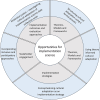Narrowing the health equity gap. How can implementation science proactively facilitate the cultural adaptation of public health innovations?
- PMID: 40397105
- PMCID: PMC12254068
- DOI: 10.1007/s00103-025-04057-x
Narrowing the health equity gap. How can implementation science proactively facilitate the cultural adaptation of public health innovations?
Abstract
While the ambitions of innovation in public health are usually geared towards improving health outcomes, an unintended consequence of the innovation process is that it can exacerbate health inequity. People who are disproportionately excluded from accessing the benefits from innovations in public health include, among others, minoritised racial and ethnic communities. Advancing racial and ethnic health equity by centring attention on systemic factors influencing health inequalities-for example, how structural racism influences public health-has gained much focus among researchers, including those in implementation science. Implementation science is a field ideally placed to actively intervene and enhance an equitable process of innovation. One of the key pieces in working towards implementing public health innovation that promotes health equity is progressing the science of adaptation. Cultural adaptation requires systematic changes to an intervention, context, or implementation activity to ensure the relevance and fit for a population, whilst retaining fidelity to the evidence-based components. In this discussion, we propose five implementation science approaches to proactively facilitate cultural adaptation in public health innovation and promote health equity. We discuss (1) structuring cultural adaptation through a formal process and (2) using theory, (3) incorporating inclusive and participatory approaches to cultural adaptation, (4) conceptualising cultural adaptation as an implementation strategy, and (5) investigating cultural adaptation to implementation science data collection tools. Further, we use an example of a precision public health program to exemplify a framework for reporting and making adaptations. Implementation science can use the practice of adaptation as part of the inclusive and equity-driven approaches to the implementation of public health innovation.
Während die Innovationsbestrebungen im Gesundheitswesen in der Regel auf eine Verbesserung der Versorgung abzielen, besteht eine unbeabsichtigte Folge des Innovationsprozesses darin, dass er gesundheitliche Ungleichheiten verschärfen kann. Zu den Menschen, die unverhältnismäßig stark von den Vorteilen der Innovationen im Gesundheitswesen ausgeschlossen sind, zählen unter anderem Angehörige von ethnischen Minderheiten. Die Förderung der gesundheitlichen Chancengleichheit von Menschen unterschiedlicher Ethnien durch die Konzentration auf systemische Faktoren, die gesundheitliche Ungleichheiten beeinflussen, z. B. wie struktureller Rassismus die öffentliche Gesundheit beeinflusst, hat bei Forschern, auch in der Implementierungswissenschaft, viel Aufmerksamkeit erlangt. Die Implementierungswissenschaft ist ein Bereich, der ideal geeignet ist, um aktiv einzugreifen und einen gerechten Innovationsprozess zu fördern. Einer der wichtigsten Aspekte bei der Umsetzung von Innovationen im Bereich der öffentlichen Gesundheit, die die gesundheitliche Chancengleichheit fördern, ist die Weiterentwicklung der Forschung im Bereich der Anpassung. Kulturelle Anpassung erfordert systematische Änderungen an einer Intervention, einem Kontext oder einer Umsetzungsaktivität, um die Relevanz und Eignung für eine Bevölkerung sicherzustellen, während die evidenzbasierten Komponenten beibehalten werden. In dieser Diskussion schlagen wir fünf Ansätze der Implementierungswissenschaft vor, um die kulturelle Anpassung bei Innovationen im Bereich der öffentlichen Gesundheit proaktiv zu erleichtern und die gesundheitliche Chancengleichheit zu fördern. Wir erörtern (1) die Strukturierung der kulturellen Anpassung mithilfe formeller Prozesse und (2) die Verwendung von Theorien, (3) Einbeziehung inklusiver und partizipativer Ansätze zur kulturellen Anpassung, (4) Konzeptualisierung der kulturellen Anpassung als Implementierungsstrategie und (5) Untersuchung der kulturellen Anpassung an die Datenerhebungsinstrumente der Implementierungswissenschaft. Darüber hinaus verwenden wir ein Fallbeispiel zur Präzisionsgesundheit im Bereich Public Health, um einen Rahmen für die Berichterstattung und Anpassungen zu veranschaulichen. Die Implementierungswissenschaft kann die Praxis der Anpassung als Teil inklusiver und auf Chancengleichheit ausgerichteter Ansätze zur Umsetzung von Innovationen im Bereich der öffentlichen Gesundheit nutzen.
Keywords: Cultural adaptation; Health equity; Implementation science; Innovation; Unintended consequences.
© 2025. The Author(s).
Conflict of interest statement
Declarations. Conflict of interest: Z. Fehlberg, M. Klaic, S. Croy, and S. Best declare that they have no competing interests. For this article no studies with human participants or animals were performed by any of the authors. All studies mentioned were in accordance with the ethical standards indicated in each case.
Figures
Similar articles
-
Accreditation through the eyes of nurse managers: an infinite staircase or a phenomenon that evaporates like water.J Health Organ Manag. 2025 Jun 30. doi: 10.1108/JHOM-01-2025-0029. Online ahead of print. J Health Organ Manag. 2025. PMID: 40574247
-
Implementing capacity-building initiatives addressing health equity through community-academic partnerships: A qualitative study.Transl Behav Med. 2025 Jan 16;15(1):ibaf017. doi: 10.1093/tbm/ibaf017. Transl Behav Med. 2025. PMID: 40557867
-
Reducing health inequalities through general practice: a realist review and action framework.Health Soc Care Deliv Res. 2024 Mar;12(7):1-104. doi: 10.3310/YTWW7032. Health Soc Care Deliv Res. 2024. PMID: 38551093
-
IM4Equity: an implementation science meta-framework for community-engaged partnerships to advance health equity.BMC Health Serv Res. 2025 Mar 26;25(1):437. doi: 10.1186/s12913-025-12537-8. BMC Health Serv Res. 2025. PMID: 40140849 Free PMC article.
-
Factors that impact on the use of mechanical ventilation weaning protocols in critically ill adults and children: a qualitative evidence-synthesis.Cochrane Database Syst Rev. 2016 Oct 4;10(10):CD011812. doi: 10.1002/14651858.CD011812.pub2. Cochrane Database Syst Rev. 2016. PMID: 27699783 Free PMC article.
References
-
- Hart TJ (1971) The Inverse Care Law. Lancet 7(1):405–412. 10.1016/S0140-6736 - PubMed
-
- Pérez-Stable EJ, Webb Hooper M (2023) The Pillars of Health Disparities Science—Race, Ethnicity, and Socioeconomic Status. Jama Health Forum 4:e234463–e234463. 10.1001/jamahealthforum.2023.4463 - PubMed
-
- Rogers EM (1962) Diffusion of innovations. Free Press of Glencoe, New York
-
- Bridges KM (2019) Critical Race Theory: A Primer. Foundation Press
Publication types
MeSH terms
LinkOut - more resources
Full Text Sources
Miscellaneous


